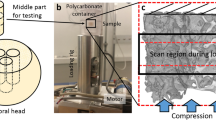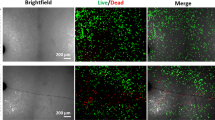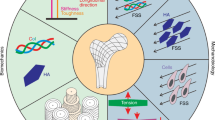Abstract
Bone is more difficult to break than to split. Although this is well known, and many studies exist on the behaviour of long cracks in bone, there is a need for data on the orientation-dependent crack-growth resistance behaviour of human cortical bone that accurately assesses its toughness at appropriate size scales. Here, we use in situ mechanical testing to examine how physiologically pertinent short (<600 μm) cracks propagate in both the transverse and longitudinal orientations in cortical bone, using both crack-deflection/twist mechanics and nonlinear-elastic fracture mechanics to determine crack-resistance curves. We find that after only 500 μm of cracking, the driving force for crack propagation was more than five times higher in the transverse (breaking) direction than in the longitudinal (splitting) direction owing to major crack deflections/twists, principally at cement sheaths. Indeed, our results show that the true transverse toughness of cortical bone is far higher than previously reported. However, the toughness in the longitudinal orientation, where cracks tend to follow the cement lines, is quite low at these small crack sizes; it is only when cracks become several millimetres in length that bridging mechanisms can fully develop leading to the (larger-crack) toughnesses generally quoted for bone.
This is a preview of subscription content, access via your institution
Access options
Subscribe to this journal
Receive 12 print issues and online access
$259.00 per year
only $21.58 per issue
Buy this article
- Purchase on Springer Link
- Instant access to full article PDF
Prices may be subject to local taxes which are calculated during checkout



Similar content being viewed by others
References
Currey, J. D. Bones (Princeton Univ. Press, Princeton, 2002).
Zioupos, P. & Currey, J. D. Changes in the stiffness, strength, and toughness of human cortical bone with age. Bone 22, 57–66 (1998).
Nalla, R. K., Kruzic, J. J., Kinney, J. H. & Ritchie, R. O. Effect of aging on the toughness of human cortical bone: Evaluation by R-curves. Bone 35, 1240–1246 (2004).
Giannoudis, P., Tzioupis, C., Almalki, T. & Buckley, R. Fracture healing in osteoporotic fractures: Is it really different? A basic science perspective. Injury Sci. Basis Fracture Healing: An Update 38, S90–S99 (2007).
Vashishth, D., Tanner, K. E. & Bonfield, W. Experimental validation of a microcracking-based toughening mechanism for cortical bone. J. Biomech. 36, 121–124 (2003).
Vashishth, D. Rising crack-growth-resistance behavior in cortical bone: Implications for toughness measurements. J. Biomech. 37, 943–946 (2004).
Ritchie, R. O., Gilbert, C. J. & McNaney, J. M. Mechanics and mechanisms of fatigue damage and crack growth in advanced materials. Int. J. Solids Struct. 37, 311–329 (2000).
Melvin, J. W. & Evans, F. G. Biomechanics Symp. 87–88 (ASME, New York, 1973).
Bonfield, W. & Datta, P. K. Fracture toughness of compact bone. J. Biomech. 9, 131–134 (1976).
Wright, T. M. & Hayes, W. C. Fracture mechanics parameters for compact bone–effects of density and specimen thickness. J. Biomech. 10, 419–425 (1977).
Bonfield, W., Grynpas, M. D. & Young, R. J. Crack velocity and the fracture of bone. J. Biomech. 11, 473–479 (1978).
Behiri, J. C. & Bonfield, W. Fracture mechanics of bone–the effects of density, specimen thickness and crack velocity on longitudinal fracture. J. Biomech. 17, 25–34 (1984).
Moyle, D. D. & Gavens, A. J. Fracture properties of bovine tibial bone. J. Biomech. 19, 919–927 (1986).
Norman, T. L., Vashishth, D. & Burr, D. B. in Advances in Bioengineering Vol. 20 (ed. Vanerby, R.) 361–364 (ASME, New York, 1991).
Norman, T. L., Vashishth, D. & Burr, D. B. Fracture toughness of human bone under tension. J. Biomech. 28, 309–320 (1995).
De Santis, R. et al. Bone fracture analysis on the short rod chevron-notch specimens using the x-ray computer micro-tomography. J. Mater. Sci. - Mater. Med. 11, 629–636 (2000).
Phelps, J. B., Hubbard, G. B., Wang, X. & Agrawal, C. M. Microstructural heterogeneity and the fracture toughness of bone. J. Biomed. Mater. Res. 51, 735–741 (2000).
Wang, X., Shen, X., Li, X. & Mauli Agrawal, C. Age-related changes in the collagen network and toughness of bone. Bone 31, 1–7 (2002).
Malik, C. L., Stover, S. M., Martin, R. B. & Gibeling, J. C. Equine cortical bone exhibits rising R-curve fracture mechanics. J. Biomech. 36, 191–198 (2003).
Yan, J., Mecholsky, J., John, J. & Clifton, K. B. How tough is bone? Application of elastic–plastic fracture mechanics to bone. Bone 40, 479–484 (2007).
Nalla, R. K., Kruzic, J. J., Kinney, J. H. & Ritchie, R. O. Mechanistic aspects of fracture and R-curve behavior in human cortical bone. Biomaterials 26, 217–231 (2005).
Fantner, G. et al. Sacrificial bonds and hidden length dissipate energy as mineralized fibrils separate during bone fracture. Nature Mater. 4, 612–616 (2005).
Vashishth, D., Behiri, J. C. & Bonfield, W. Crack growth resistance in cortical bone: Concept of microcrack toughening. J. Biomech. 30, 763–769 (1997).
Vashishth, D. Rising crack-growth-resistance behavior in cortical bone: Implications for toughness measurements. J. Biomech. 37, 943–946 (2004).
Brown, C. U., Yeni, Y. N. & Norman, T. L. Fracture toughness is dependent on bone location—a study of the femoral neck, femoral shaft, and the tibial shaft. J. Biomed. Mater. Res. 49, 380–389 (2000).
Parasamian, G. & Norman, T. Diffuse damage accumulation in the fracture process zone of human cortical bone specimens and its influence on fracture toughness. J. Mater. Sci. - Mater. Med. 12, 779–783 (2001).
Peterlik, H., Roschger, P., Klaushoffer, K. & Fratzl, P. From brittle to ductile fracture of bone. Nature Mater. 5, 52–55 (2006).
Nalla, R. K., Kinney, J. H. & Ritchie, R. O. Mechanistic fracture criteria for the failure of human cortical bone. Nature Mater. 2, 164–168 (2003).
Yeni, Y. N. & Fyhrie, D. P. A rate-dependent microcrack-bridging model that can explain the strain rate dependency of cortical bone apparent yield strength. J. Biomech. 36, 1343–1353 (2003).
Behiri, J. C. & Bonfield, W. Orientation dependence of the fracture mechanics of cortical bone. J. Biomech. 22, 863–867 (1989).
Knott, J. F. Fundamentals of Fracture Mechanics (Butterworth & Co., London, 1976).
Mullins, L., Bruzzi, M. & McHugh, P. Measurement of microstructural fracture toughness of cortical bone using indentation toughness. J. Biomech. 40, 3285–3288 (2007).
Burr, D. B. & Martin, R. B. Calculating the probability that microcracks initiate resorption spaces. J. Biomech. 26, 613–616 (1993).
Taylor, D., Hazenberg, J. G. & Lee, T. C. Living with cracks: Damage and repair in human bone. Nature Mater. 6, 249–317 (2007).
Yeni, Y. & Norman, T. L. Calculation of porosity and osteonal cement line effects on the effective fracture toughness of cortical bone in longitudinal crack growth. J. Biomed. Mater. Res. 51, 504–509 (2000).
Cook, J., Gordon, J. E., Evans, C. C. & Marsh, D. M. A mechanism for the control of crack propagation in all-brittle systems. Proc. R. Soc. Lond. A 282, 508–520 (1964).
Evans, A. G. & Faber, K. T. Crack-growth resistance of microcracking brittle materials. J. Am. Ceram. Soc. 67, 255–260 (1984).
Nalla, R. K., Stölken, J. S., Kinney, J. H. & Ritchie, R. O. Fracture in human cortical bone: Local fracture criteria and toughening mechanisms. J. Biomech. 38, 1517–1525 (2005).
Koester, K. J., Ager, J. W. III & Ritchie, R. O. The effect of aging on crack-growth resistance and toughening mechanisms in human dentin. Biomaterials 29, 1318–1328 (2008).
Cotterell, B. & Rice, J. R. Slightly curved or kinked cracks. Int. J. Fract. 16, 155–169 (1980).
Faber, K. T. & Evans, A. G. Crack deflection process—I theory. Acta Metall. 31, 565–576 (1983).
E1820, Standard test method for measurement of fracture toughness (American Society for Testing and Materials, West Conshohocken, PA, 2006).
Rice, J. R. A path independent integral and the approximate analysis of strain concentration by notches and cracks. J. Appl. Mech. 35, 379–386 (1968).
Yang, Q. D., Cox, B. N., Nalla, R. K. & Ritchie, R. O. Re-evaluating the toughness of human cortical bone. Bone 38, 878–887 (2006).
Acknowledgements
This work was supported by the Director, Office of Science, Office of Basic Energy Sciences, Division of Materials Sciences and Engineering, of the US Department of Energy under contract no. DE-AC02-05CH11231, and by the Laboratory Directed Research and Development Program of Lawrence Berkeley National Laboratory (LBNL). Computed X-ray tomography was carried out at LBNL’s Advanced Light Source, which is supported under the same contract. The authors thank H. Barth for help in preparing the X-ray computed tomographs.
Author information
Authors and Affiliations
Contributions
R.O.R. had full access to the experimental data in the study and takes responsibility for the integrity of the data and the accuracy of the data analysis. Data acquisition was carried out by K.J.K. Study design, interpretation and analysis of data and preparation of the manuscript were performed jointly by K.J.K., J.W.A. and R.O.R.
Corresponding author
Supplementary information
Supplementary Information
Supplementary Movie 1 (MOV 4135 kb)
Supplementary Information
Supplementary Movie 2 (MOV 4687 kb)
Rights and permissions
About this article
Cite this article
Koester, K., Ager, J. & Ritchie, R. The true toughness of human cortical bone measured with realistically short cracks. Nature Mater 7, 672–677 (2008). https://doi.org/10.1038/nmat2221
Received:
Accepted:
Published:
Issue Date:
DOI: https://doi.org/10.1038/nmat2221
This article is cited by
-
An analysis of interfacial debonding in beaded fiber composites
International Journal of Fracture (2024)
-
Multiscale Effects of Collagen Damage in Cortical Bone and Dentin
JOM (2023)
-
Graphene oxide bulk material reinforced by heterophase platelets with multiscale interface crosslinking
Nature Materials (2022)
-
Interlocking design, programmable laser manufacturing and testing for architectured ceramics
Scientific Reports (2022)
-
Unraveling the effect of collagen damage on bone fracture using in situ synchrotron microtomography with deep learning
Communications Materials (2022)



